Spatio-Temporal Characteristics of Drought and Its Relationship with El Niño-Southern Oscillation in the Songhua River Basin from 1960 to 2019
Abstract
:1. Introduction
2. Study Area
3. Data and Methods
3.1. Data
3.2. The Standardized Precipitation Evapotranspiration Index
- First, the PET was calculated using the Penman–Monteith model as shown below:where is the reference crop evapotranspiration, ; is the net radiation on the canopy surface, ; is the soil heat flux, ; is the average temperature, °C; is the saturation vapor pressure, ; is the actual vapor pressure, ; is the slope of the tangent line of the saturation vapor pressure—air temperature relationship curve at the temperature, °C; is the hygrometer constant, °C; and is the wind speed above the ground, .
- Then, the difference between the monthly precipitation and PET was calculated using the following equation:where is the difference between the precipitation and PET at the time and and are the monthly precipitation and PET at the time.
- Next, the difference of the precipitation and evapotranspiration at different time scales was calculated using the equation mentioned below:where is the time scale (1 month, 3 months, and 12 months) and is the calculation frequency.
- Next, the three-parameter log-logistic probability distribution was used to normalize the D series and to further calculate the SPEI. For each D value, the normalized value was calculated as follows:The parameters mentioned before were calculated with the following equations:where is a factorial function and is the probability-weighted moment of D data series:where N is the number of months in the calculation.
- Finally, the cumulative probability density was standardized as follows:When the cumulative probability :where the constants were assigned the values of 2.515517, 0.802853, 0.010328, 1.432788, 0.189269, and 0.001308, respectively [30].
3.3. Analysis Methods
4. Results
4.1. Spatio-Temporal Distribution of Precipitation
4.2. Temporal Variation of the SPEI
4.3. Frequency of Drought Events with Different Time Scales
4.4. Correlation between the SPEI and El Niño-Southern Oscillation Indexes
5. Discussion
5.1. Relationship between Precipitation and SPEI
5.2. Effect of the El Niño-Southern Oscillation on Drought
5.3. Effect of the Drought on Agriculture
6. Conclusions
- The average annual, spring, summer, autumn, and winter precipitations were 527 mm, 76 mm, 348 mm, 87 mm, and 14 mm, respectively. About 66% of the total annual precipitation was concentrated in summer. The change trends of yearly, spring, summer, autumn, and winter precipitation were 0.56, 1.47 (p < 0.05), 0.13, 0.04, and 0.16 (p < 0.05) mm/a, respectively. The monthly precipitation increased in all months except August and September, and the increase in precipitation was significant (p < 0.05) in February, March, May, November, and December. The precipitation in the SHRB was higher in the southeastern regions, with the highest value of 831.62 mm, and was lower in the western regions, with the lowest value of 381.69 mm.
- The trend of annual SPEI significantly increased (p < 0.05), with a gradient of 0.01/a. The SPEI in the SHRB increased in all seasons and were significant in winter (p < 0.05). The monthly SPEI increased in almost all months except March, with a gradient of −0.0009/a, and was significantly increased (p < 0.01) in January, with a gradient of 0.02/a. The SHRB had a wetting trend from 1960 to 2019.
- Severe drought occurred in 1966, 1967, 1982, 1989, and 2019, when six months of draught were experienced. The years without drought were 1986, 2013, and 2018. The drought months in a year from 1980 to 2019 were less than those from 1960 to 1979. The frequencies of drought, normal, and wet for all periods ranged from 20 to 31%, 39 to 58%, and 20 to 32%, respectively. The drought probability distribution on the yearly scale was similar to that in summer and autumn, and the drought probability on a yearly scale was dominated by summer and autumn.
- The SPEI was positively correlated with SST1, SST2, SST3, and SST4, in a different period with a different resonant period. Moreover, the SPEI was negatively correlated with the SOI for a short-term period of 3–4 years from 1986 to 1990 and for a long-term period of 9–12 years from 1992 to 2010. A decrease in the El Niño index or an increase in the Southern Oscillation index could result in a drought event.
Author Contributions
Funding
Institutional Review Board Statement
Informed Consent Statement
Data Availability Statement
Acknowledgments
Conflicts of Interest
References
- Panagoulia, D.; Dimou, G. Definitions and effects of droughts. In Proceedings of the Conference on Mediterranean Water Policy: Building on Existing Experience, Mediterranean Water Network, Valencia, Spain, 23 April 1998; Volume 1, p. 11. Available online: https://www.researchgate.net/publication/273728913_definitions_and_effects_of_droughts (accessed on 4 March 2022).
- Panagoulia, D.; Dimou, G. Climatic instability and low-flow regimes. In Proceedings of the Water Resources Management under Drought or Water Shortage Conditions, EWRA 95 Symposium, Nicosia, Cyprus, 14–18 March 1995; Tsiourtis, N.X., Ed.; August Aimé Balkema: Amsterdam, The Netherlands, 1995; pp. 29–34. [Google Scholar]
- Chen, T.; Xia, G.; Liu, T.; Chen, W.; Chi, D. Assessment of drought impact on main cereal crops using a standardized precipitation evapotranspiration index in Liaoning Province, China. Sustainability 2016, 8, 1069. [Google Scholar] [CrossRef] [Green Version]
- Guo, E.; Liu, X.; Zhang, J.; Wang, Y.; Wang, C.; Wang, R.; Li, D. Assessing spatiotemporal variation of drought and its impact on maize yield in Northeast China. J. Hydrol. 2017, 553, 231–247. [Google Scholar] [CrossRef]
- Parsons, D.J.; Rey, D.; Tanguy, M.; Holman, I.P. Regional variations in the link between drought indices and reported agricultural impacts of drought. Agric. Syst. 2019, 173, 119–129. [Google Scholar] [CrossRef]
- Liu, X.; Pan, Y.; Zhu, X.; Yang, T.; Bai, J.; Sun, Z. Drought evolution and its impact on the crop yield in the North China Plain. J. Hydrol. 2018, 564, 984–996. [Google Scholar] [CrossRef]
- Espinosa, L.A.; Portela, M.M.; Rodrigues, R. Spatio-temporal variability of droughts over past 80 years in Madeira Island. J. Hydrol. -Reg. Stud. 2019, 25. [Google Scholar] [CrossRef]
- Li, Z.; Huang, S.; Zhou, S.; Leng, G.; Liu, D.; Huang, Q.; Wang, H.; Han, Z.; Liang, H. Clarifying the propagation dynamics from meteorological to hydrological drought induced by climate change and direct human activities. J. Hydrometeorol. 2021, 22, 2359–2378. [Google Scholar] [CrossRef]
- Ding, Y.; Gong, X.; Xing, Z.; Cai, H.; Zhou, Z.; Zhang, D.; Sun, P.; Shi, H. Attribution of meteorological, hydrological and agricultural drought propagation in different climatic regions of China. Agric. Water Manag. 2021, 255. [Google Scholar] [CrossRef]
- McKee, T.B.; Doesken, N.J.; Kleist, J. The relationship of drought frequency and duration to time scales. In Proceedings of the 8th Conference on Applied Climatology, Anaheim, CA, USA, 17–22 January 1993; pp. 179–183. [Google Scholar]
- Vicente-Serrano, S.M.; Beguería, S.; López-Moreno, J.I. A multiscalar drought index sensitive to global warming: The standardized precipitation evapotranspiration index. J. Clim. 2010, 23, 1696–1718. [Google Scholar] [CrossRef] [Green Version]
- Palmer, W.C. Meteorological Drought; US Department of Commerce, Weather Bureau: Washington, DC, USA, 1965; Volume 30.
- Rajsekhar, D.; Singh, V.P.; Mishra, A.K. Multivariate drought index: An information theory based approach for integrated drought assessment. J. Hydrol. 2015, 526, 164–182. [Google Scholar] [CrossRef]
- Shah, D.; Mishra, V. Integrated Drought Index (IDI) for drought monitoring and assessment in India. Water Resour. Res. 2020, 56, e2019WR026284. [Google Scholar] [CrossRef]
- Tan, C.; Yang, J.; Li, M. Temporal-spatial variation of drought indicated by SPI and SPEI in Ningxia Hui Autonomous Region, China. Atmosphere 2015, 6, 1399–1421. [Google Scholar] [CrossRef] [Green Version]
- Bae, S.; Lee, S.-H.; Yoo, S.-H.; Kim, T. Analysis of drought intensity and trends using the modified SPEI in South Korea from 1981 to 2010. Water 2018, 10, 327. [Google Scholar] [CrossRef] [Green Version]
- Jin, X.; Qiang, H.; Zhao, L.; Jiang, S.; Cui, N.; Cao, Y.; Feng, Y. SPEI-based analysis of spatio-temporal variation characteristics for annual and seasonal drought in the Zoige Wetland, Southwest China from 1961 to 2016. Theor. Appl. Climatol. 2020, 139, 711–725. [Google Scholar] [CrossRef]
- Chen, H. and J. Sun, Changes in drought characteristics over china using the standardized precipitation evapotranspiration index. J. Clim. 2015, 28, 5430–5447. [Google Scholar] [CrossRef]
- Masson-Delmotte, V.; Zhai, P.; Pörtner, H.-O.; Roberts, D.; Skea, J.; Shukla, P.R.; Pirani, A.; Moufouma-Okia, W.; Péan, C.; Pidcock, R. Global warming of 1.5 °C; World Meteorological Organization: Geneva, Switzerland, 2018; Volume 1. [Google Scholar]
- Li, H.; Chen, H.; Wang, H.; Yu, E. Future precipitation changes over China under 1.5 C and 2.0 C global warming targets by using CORDEX regional climate models. Sci. Total Environ. 2018, 640, 543–554. [Google Scholar] [CrossRef]
- Mukherjee, S.; Mishra, A.; Trenberth, K.E. Climate change and drought: A perspective on drought indices. Curr. Clim. Chang. Rep. 2018, 4, 145–163. [Google Scholar] [CrossRef]
- Li, M.; Cao, F.; Wang, G.; Chai, X.; Zhang, L. Evolutional characteristics of regional meteorological drought and their linkages with southern oscillation index across the loess plateau of China during 1962–2017. Sustainability 2020, 12, 7237. [Google Scholar] [CrossRef]
- Du, Y.; Berndtsson, R.; An, D.; Zhang, L.; Yuan, F.; Hao, Z. Integrated large-scale circulation impact on rainy season precipitation in the source region of the Yangtze River. Int. J. Climatol. 2020, 40, 2285–2295. [Google Scholar] [CrossRef]
- Tong, S.; Li, X.; Zhang, J.; Bao, Y.; Bao, Y.; Na, L.; Si, A. Spatial and temporal variability in extreme temperature and precipitation events in Inner Mongolia (China) during 1960–2017. Sci. Total Environ. 2019, 649, 75–89. [Google Scholar] [CrossRef]
- Mo, K.C.; Schemm, J.E. Relationships between ENSO and drought over the southeastern United States. Geophys. Res. Lett. 2008, 35, 35. [Google Scholar] [CrossRef]
- Wang, H.; Kumar, A. Assessing the impact of ENSO on drought in the US Southwest with NCEP climate model simulations. J. Hydrol. 2015, 526, 30–41. [Google Scholar] [CrossRef]
- Zhou, L.; Wang, S.; Du, M.; Chen, Q.; He, C.; Zhang, J.; Zhu, Y.; Gong, Y. The influence of ENSO and MJO on drought in different ecological geographic regions in China. Remote Sens. 2021, 13, 875. [Google Scholar] [CrossRef]
- Compilation group of China Flood and Drought Disaster Prevention Bulletin. Summary of China Flood and Drought Disaster Prevention Bulletin 2020. China Flood Drought Manag. 2021, 31, 26–32. [Google Scholar] [CrossRef]
- Faiz, M.A.; Liu, D.; Fu, Q.; Baig, F.; Tahir, A.A.; Li, M.; Khan, M.I.; Shoaib, M.; Li, T.; Cui, S. Multi-index drought characteristics in Songhua River basin, Northeast China. Clim. Res. 2019, 78, 1–19. [Google Scholar] [CrossRef]
- An, Q.; He, H.; Gao, J.; Nie, Q.; Cui, Y.; Wei, C.; Xie, X. Analysis of temporal-spatial variation characteristics of drought: A case study from Xinjiang, China. Water 2020, 12, 741. [Google Scholar] [CrossRef] [Green Version]
- Huang, H.; Zhang, B.; Cui, Y.; Ma, S. Analysis on the characteristics of dry and wet periods in the yangtze river basin. Water 2020, 12, 2960. [Google Scholar] [CrossRef]
- Khorsandi, N.; Mahdian, M.H.; Pazira, E.; Nikkami, D.; Chamheidar, H. Comparison of different interpolation methods for investigating spatial variability of rainfall erosivity index. Pol. J. Environ. Stud. 2012, 21, 1659–1666. [Google Scholar]
- Weisberg, S. Applied Linear Regression; John Wiley & Sons: New York, NY, USA, 2005; Volume 528. [Google Scholar]
- Tiku, M. Tables of the power of the F-test. J. Am. Stat. Assoc. 1967, 62, 525–539. [Google Scholar] [CrossRef]
- Hamed, K.H.; Rao, A.R. A modified Mann-Kendall trend test for autocorrelated data. J. Hydrol. 1998, 204, 182–196. [Google Scholar] [CrossRef]
- Adamowski, J.F. Development of a short-term river flood forecasting method for snowmelt driven floods based on wavelet and cross-wavelet analysis. J. Hydrol. 2008, 353, 247–266. [Google Scholar] [CrossRef]
- Ghaderpour, E.; Vujadinovic, T.; Hassan, Q.K. Application of the least-squares wavelet software in hydrology: Athabasca River basin. J. Hydrol. Reg. Stud. 2021, 36, 100847. [Google Scholar] [CrossRef]
- Miao, J.; Liu, G.; Cao, B.; Hao, Y.; Chen, J.; Yeh, T.; Chyi, J. Identification of strong karst groundwater runoff belt by cross wavelet transform. Water Resour. Manag. 2014, 28, 2903–2916. [Google Scholar] [CrossRef]
- Torrence, C.; Compo, G.P. A practical guide to wavelet analysis. Bull. Am. Meteorol. Soc. 1998, 79, 61–78. [Google Scholar] [CrossRef] [Green Version]
- Bi, S.; Bi, S.; Lu, Y.; Qu, Y.; Zhao, F. Temporal and spatial characteristics of droughts and floods in northern China from 1644 to 1911. J. Earth Syst. Sci. 2019, 128, 98. [Google Scholar] [CrossRef] [Green Version]
- Du, C.; Chen, J.; Nie, T.; Dai, C. Spatial-temporal changes in meteorological and agricultural droughts in Northeast China: Change patterns, response relationships and causes. Nat. Hazards 2021, 110, 155–173. [Google Scholar] [CrossRef]
- Ndehedehe, C.E.; Ferreira, V.G.; Agutu, N.O.; Onojeghuo, A.O.; Okwuashi, O.; Kassahun, H.T.; Dewan, A. What if the rains do not come? J. Hydrol. 2021, 595, 126040. [Google Scholar] [CrossRef]
- Wang, L.N.; Zhu, Q.K.; Zhao, W.J.; Zhao, X.K. The drought trend and its relationship with rainfall intensity in the Loess Plateau of China. Nat. Hazards 2015, 77, 479–495. [Google Scholar] [CrossRef]
- Tang, H.; Wen, T.; Shi, P.; Qu, S.; Zhao, L.; Li, Q. Analysis of characteristics of hydrological and meteorological drought evolution in Southwest China. Water 2021, 13, 1846. [Google Scholar] [CrossRef]
- Liu, B.; Shao, M. Modeling soil-water dynamics and soil-water carrying capacity for vegetation on the Loess Plateau, China. Agric. Water Manag. 2015, 159, 176–184. [Google Scholar] [CrossRef]
- Fu, B.; Xu, P.; Wang, Y.; Yan, K.; Chaudhary, S. Assessment of the ecosystem services provided by ponds in hilly areas. Sci. Total Environ. 2018, 642, 979–987. [Google Scholar] [CrossRef]
- Ji, H.; Chen, S.; Pan, S.; Xu, C.; Jiang, C.; Fan, Y. Morphological variability of the active Yellow River mouth under the new regime of riverine delivery. J. Hydrol. 2018, 564, 329–341. [Google Scholar] [CrossRef]
- Apurv, T.; Sivapalan, M.; Cai, X. Understanding the role of climate characteristics in drought propagation. Water Resour. Res. 2017, 53, 9304–9329. [Google Scholar] [CrossRef] [Green Version]
- Islam, A.R.M.; Salam, R.; Yeasmin, N.; Kamruzzaman, M.; Shahid, S.; Fattah, M.; Uddin, A.; Shahariar, M.H.; Mondol, M.A.H.; Jhajharia, D. Spatiotemporal distribution of drought and its possible associations with ENSO indices in Bangladesh. Arab J. Geosci. 2021, 14, 2681. [Google Scholar] [CrossRef]
- Sun, P.; Zhang, Q.; Cheng, C.; Singh, V.P.; Shi, P. ENSO-induced drought hazards and wet spells and related agricultural losses across Anhui province, China. Nat. Hazards 2017, 89, 963–983. [Google Scholar] [CrossRef]
- Aryal, Y.; Zhu, J. Evaluating the performance of regional climate models to simulate the US drought and its connection with El Nino Southern Oscillation. Theor. Appl. Climatol. 2021, 145, 1259–1273. [Google Scholar] [CrossRef]
- Gupta, V.; Jain, M.K. Unravelling the teleconnections between ENSO and dry/wet conditions over India using nonlinear Granger causality. Atmos Res. 2021, 247, 105168. [Google Scholar] [CrossRef]
- Aryal, Y.; Zhu, J. Multimodel ensemble projection of meteorological drought scenarios and connection with climate based on spectral analysis. Int. J. Climatol. 2020, 40, 3360–3379. [Google Scholar] [CrossRef]
- Zhou, F.; Fang, K.; Zhang, F.; Dong, Z. Hydroclimate change encoded in tree rings of Fengshui woods in Southeastern China and its teleconnection with El Niño-Southern Oscillation. Water Resour. Res. 2020, 56, e2018WR024612. [Google Scholar] [CrossRef]
- Gong, X.; Du, S.; Li, F.; Ding, Y. Study on the spatial and temporal characteristics of mesoscale drought in china under future climate change scenarios. Water 2021, 13, 2761. [Google Scholar] [CrossRef]
- Woolway, R.I.; Kraemer, B.M.; Lenters, J.D.; Merchant, C.J.; O’Reilly, C.M.; Sharma, S. Global lake responses to climate change. Nat. Rev. Earth Environ. 2020, 1, 388–403. [Google Scholar] [CrossRef]
- Gao, H.; Yang, S. A severe drought event in northern China in winter 2008–2009 and the possible influences of La Nina and Tibetan Plateau. J. Geophys. Res. Atmos. 2009, 114, 114. [Google Scholar] [CrossRef]
- Rodrigues, R.R.; McPhaden, M.J. Why did the 2011–2012 La Nina cause a severe drought in the Brazilian Northeast? Geophys. Res. Lett. 2014, 41, 1012–1018. [Google Scholar] [CrossRef]
- You, Y.; Liu, J.; Zhang, Y.; Beck, H.E.; Gu, X.; Kong, D. Impacts of El Nino-southern oscillation on global runoff: Characteristic signatures and potential mechanisms. Hydrol. Process. 2021, 35, e14367. [Google Scholar] [CrossRef]
- Zhang, W.; Jin, F.-F.; Turner, A. Increasing autumn drought over southern China associated with ENSO regime shift. Geophys. Res. Lett. 2014, 41, 4020–4026. [Google Scholar] [CrossRef] [Green Version]
- Pan, X.; Chin, M.; Ichoku, C.M.; Field, R.D. Connecting Indonesian fires and drought with the type of El Nino and phase of the Indian Ocean Dipole during 1979–2016. J. Geophys. Res. Atmos. 2018, 123, 7974–7988. [Google Scholar] [CrossRef]
- Hamal, K.; Sharma, S.; Khadka, N.; Haile, G.G.; Joshi, B.B.; Xu, T.; Dawadi, B. Assessment of drought impacts on crop yields across Nepal during 1987–2017. Meteorol. Appl. 2020, 27, 27. [Google Scholar] [CrossRef]
- Li, H.; Li, Y.; Huang, G.; Sun, J. Probabilistic assessment of crop yield loss to drought time-scales in Xinjiang, China. Int. J. Climatol. 2021, 41, 4077–4094. [Google Scholar] [CrossRef]
- Zhang, Q.; Shi, R.; Singh, V.P.; Xu, C.-Y.; Yu, H.; Fan, K.; Wu, Z. Droughts across China: Drought factors, prediction and impacts. Sci. Total Environ. 2022, 803, 150018. [Google Scholar] [CrossRef]
- Jia, H.-C.; Pan, D.-H.; Li, J.; Zhang, W.-C.; Ghulam, R. Risk assessment of maize drought disaster in southwest China using the Environmental Policy Integrated Climate model. J. Mt. Sci. 2016, 13, 465–475. [Google Scholar] [CrossRef]
- Wu, L.; Feng, L.; Li, Y.; Wang, J.; Wu, L. A yield-related agricultural drought index reveals spatio-temporal characteristics of droughts in Southwestern China. Sustainability 2019, 11, 714. [Google Scholar] [CrossRef] [Green Version]


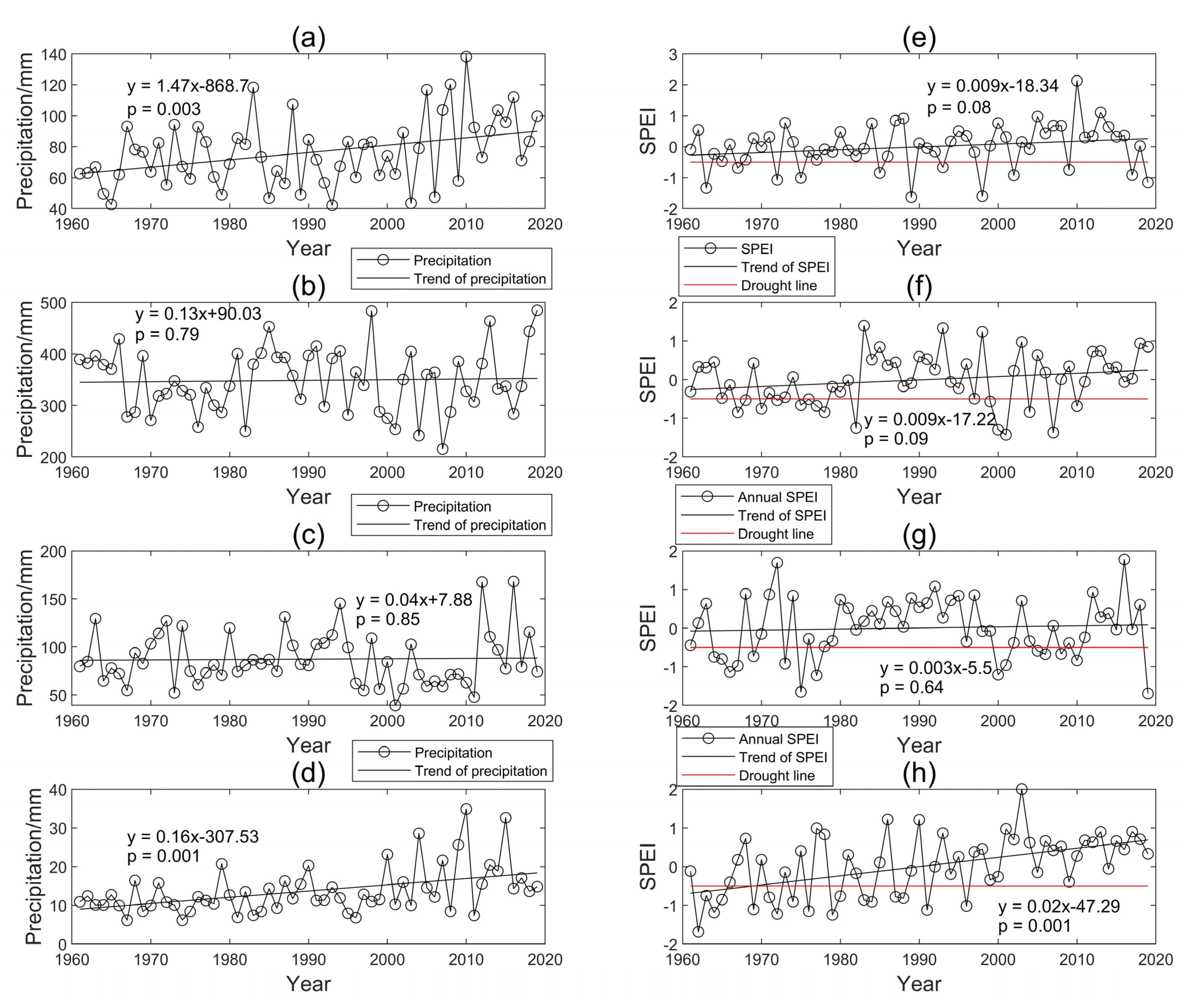
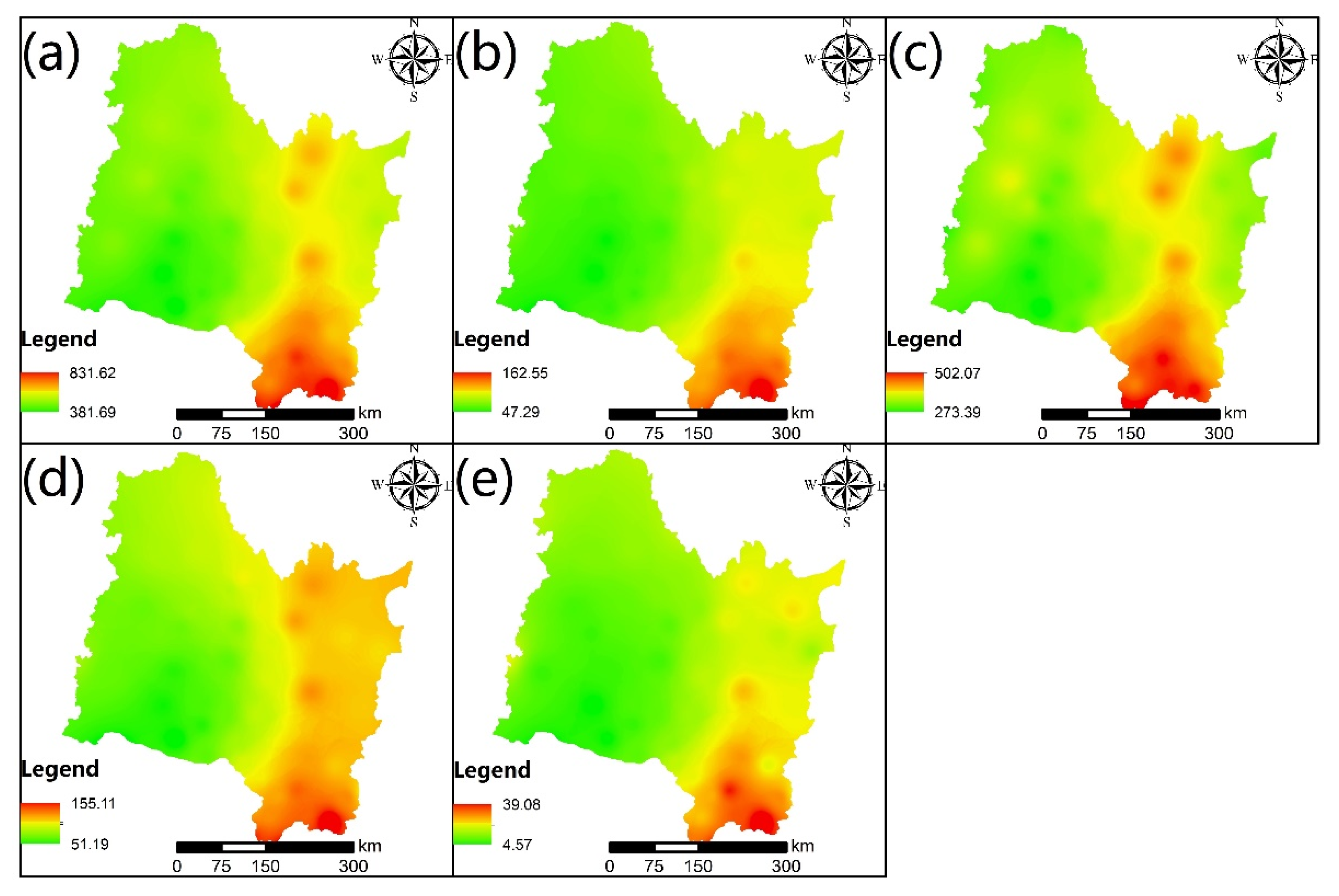
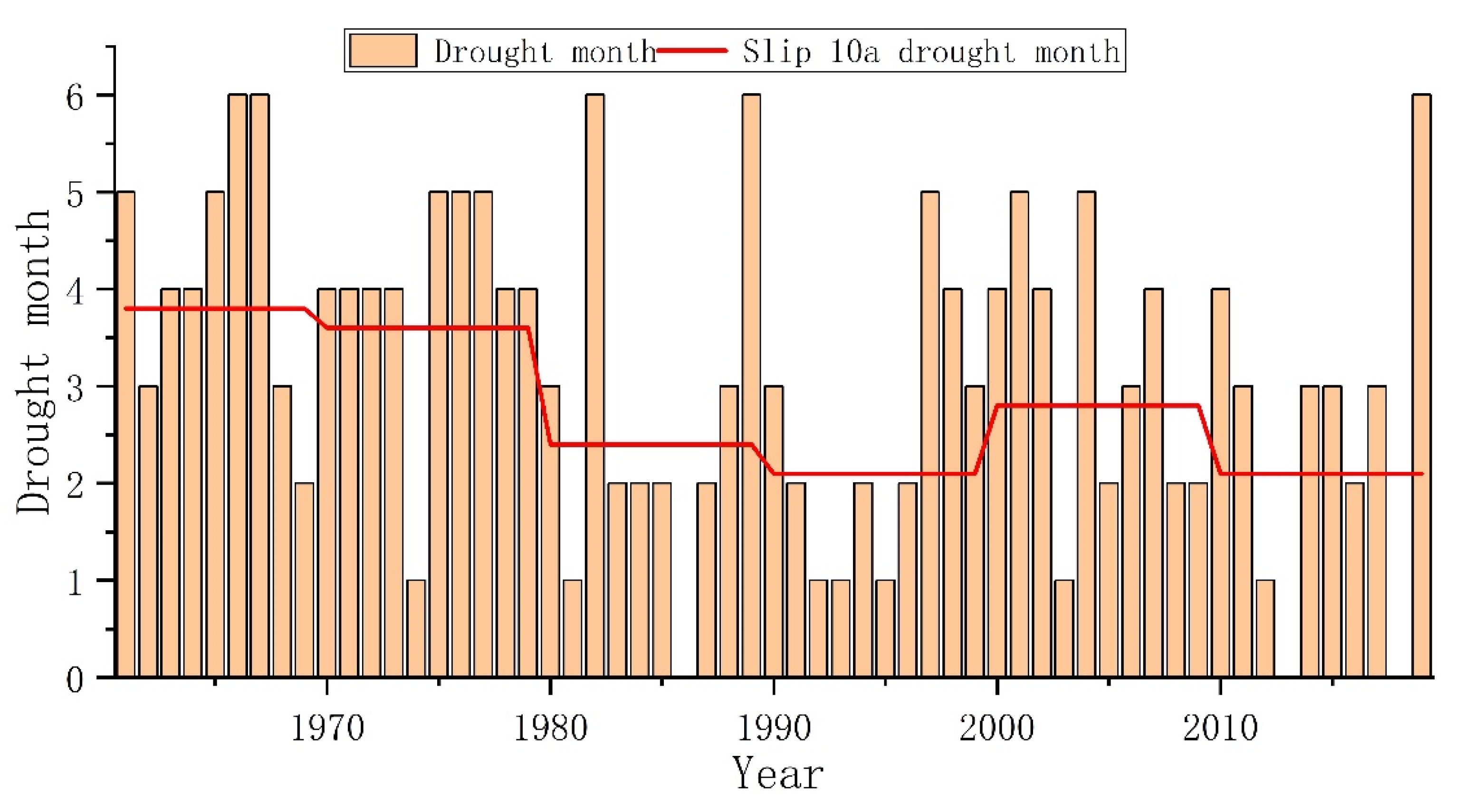



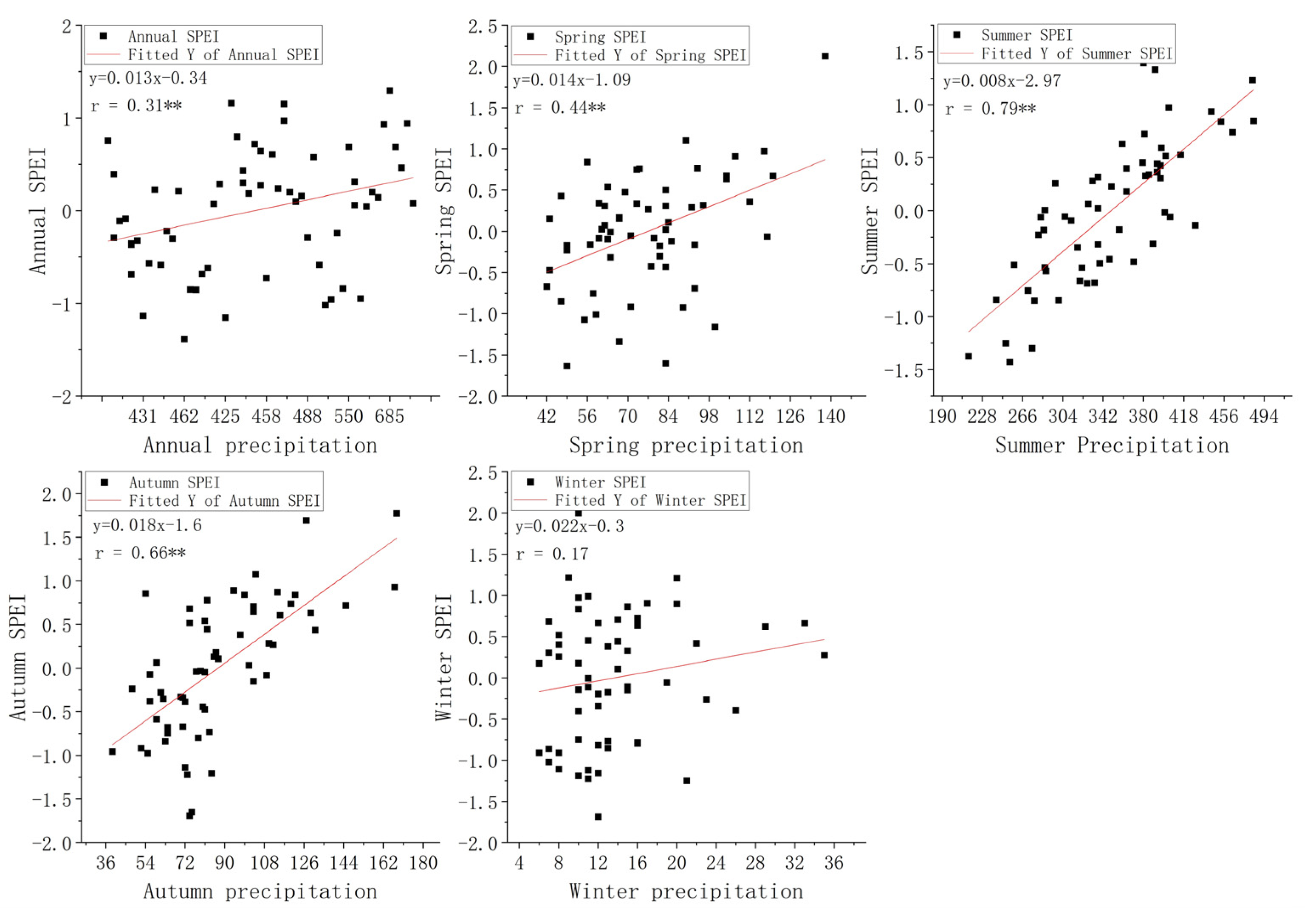
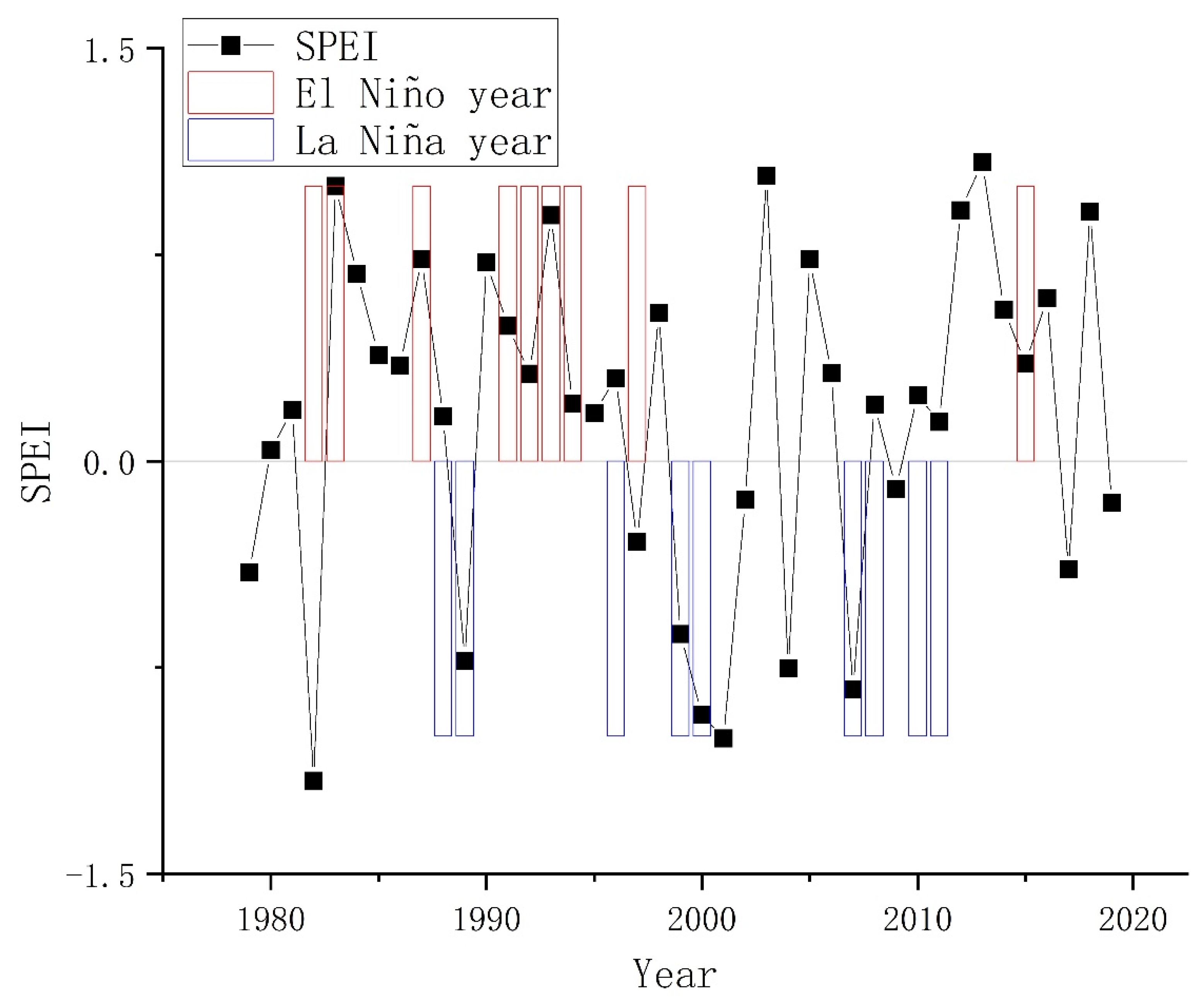
| The State of Drought and Wet | Range of the SPEI |
|---|---|
| Wet | 0.5 < SPEI |
| Normal | −0.5 < SPEI ≤ 0.5 |
| Slight drought | −1.0 < SPEI ≤ −0.5 |
| Middle drought | −2.0 < SPEI ≤ −1.0 |
| Extreme drought | SPEI ≤ −2.0 |
| Time Period | Z-Value | |
|---|---|---|
| Precipitation | SPEI | |
| Spring | 1.9 * | 2.04 * |
| Summer | 0.1 | 1.82 * |
| Autumn | −0.47 | 0.56 * |
| Winter | 1.86 * | 2.09 * |
| Annual | 0.82 | 1.65 * |
| Time Period | Z-Value | Time Period | Z-Value | ||
|---|---|---|---|---|---|
| Precipitation | SPEI | Precipitation | SPEI | ||
| January | 0.88 | 1.98 * | July | −0.99 | 1.15 |
| February | 0.79 | 2.44 * | August | −0.6 | 0.08 |
| March | 1.53 | −0.45 | September | −1.03 | −0.38 |
| April | 0.67 | 0.89 | October | 1.24 | 1.75 * |
| May | 1.09 | 1.74 * | November | 1.31 | 0.86 |
| June | 2.15 * | 2.65 * | December | 1.88 * | 1.68 * |
| Month | Precipitation | SPEI | Month | Precipitation | SPEI | ||
|---|---|---|---|---|---|---|---|
| Mean Value | Trend | Trend | Mean Value | Trend | Trend | ||
| January | 3.45 | 0.02/a | 0.02/a ** | July | 146.08 | 0.3/a | 0.004/a |
| February | 4.14 | 0.04/a * | 0.009/a | August | 115.96 | −0.07/a | 0.002/a |
| March | 8.91 | 0.08/a * | −0.0009/a | September | 53.63 | −0.12/a | 0.0009/a |
| April | 21.98 | 0.02/a | 0.003/a | October | 23.70 | 0.02/a | 0.006/a |
| May | 45.74 | 0.31/a * | 0.009/a | November | 10.19 | 0.09/a * | 0.005/a |
| June | 87.58 | 0.38/a | 0.009/a | December | 6.07 | 0.09/a * | 0.01/a |
| Month | R | Month | R |
|---|---|---|---|
| January | 0.008 | July | 0.71 ** |
| February | 0.04 | August | 0.86 ** |
| March | 0.44 ** | September | 0.76 ** |
| April | 0.59 ** | October | 0.39 ** |
| May | 0.67 ** | November | 0.05 |
| June | 0.82 ** | December | 0.32 * |
Publisher’s Note: MDPI stays neutral with regard to jurisdictional claims in published maps and institutional affiliations. |
© 2022 by the authors. Licensee MDPI, Basel, Switzerland. This article is an open access article distributed under the terms and conditions of the Creative Commons Attribution (CC BY) license (https://creativecommons.org/licenses/by/4.0/).
Share and Cite
Ren, L.; Dong, X. Spatio-Temporal Characteristics of Drought and Its Relationship with El Niño-Southern Oscillation in the Songhua River Basin from 1960 to 2019. Water 2022, 14, 866. https://doi.org/10.3390/w14060866
Ren L, Dong X. Spatio-Temporal Characteristics of Drought and Its Relationship with El Niño-Southern Oscillation in the Songhua River Basin from 1960 to 2019. Water. 2022; 14(6):866. https://doi.org/10.3390/w14060866
Chicago/Turabian StyleRen, Lv, and Xiaohua Dong. 2022. "Spatio-Temporal Characteristics of Drought and Its Relationship with El Niño-Southern Oscillation in the Songhua River Basin from 1960 to 2019" Water 14, no. 6: 866. https://doi.org/10.3390/w14060866
APA StyleRen, L., & Dong, X. (2022). Spatio-Temporal Characteristics of Drought and Its Relationship with El Niño-Southern Oscillation in the Songhua River Basin from 1960 to 2019. Water, 14(6), 866. https://doi.org/10.3390/w14060866






